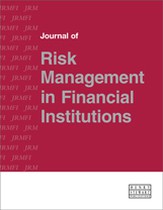Credit valuation adjustment tail risk and the impact of wrong way trades
Abstract
Actively pricing and hedging credit valuation adjustment (CVA) has quickly emerged as a core function in banks. One of the major functions of the CVA desk is to risk manage CVA. It is well known that wrong way risk has a significant impact on both CVA itself, as well as on the CVA sensitivities (ie the Greeks). This means that wrong way risk can significantly impact the CVA desk hedging strategy. While wrong way risk may have a significant impact on CVA and CVA sensitivity, it is natural to expect that the effect on the tail risk of CVA, and hence the required capital, is even greater. This is an important consideration for the CVA desk as tail risks typically remain unhedged in practice and need to bear capital. In addition, to the extent that a CVA desk tries to hedge some tail risk, this is frequently done in the form of out-of-the money options on either the market instruments (interest rates, foreign exchange (FX), etc.) or credit instruments (credit default swap index or tranches). Since these instruments do not capture the wrong way risk dynamic (they do not have both the market and credit component), they typically are not suitable for completely offsetting the wrong way risk in the CVA book. This paper analyses the impact of wrong way risks on both CVA itself as well as on the tail risks of CVA. It demonstrates that the induced tail risk adjustment to account for wrong-way risk can be more significant than the impact on CVA itself. Hence, the CVA capital impact of wrong way risk can be larger than the CVA pricing impact of the wrong way risk.
The full article is available to subscribers to the journal.
Author's Biography
Jimmy Skoglund is Principal Product Manager at SAS. He has more than 15 years’ experience developing and implementing risk methodologies, both at SAS and previously with banks. Jimmy has worked in various areas of risk management, including market, credit and liquidity risk. He holds a PhD from Stockholm School of Economics and is a regular contributor to publications in risk and finance journals and has also published a comprehensive financial risk management book with Wiley Finance.
Doug Vestal a former credit valuation adjustment (CVA) trader at Barclays and UBS, is now the capital markets lead at SAS Institute. He priced up-front credit charges across rates, foreign exchange, credit and bespoke structures and managed profit and loss volatility through trading different credit derivative instruments. He was also responsible for risk managing new securitisation vehicles that tranched International Swaps and Derivatives Association (ISDA) close-out amounts. He holds a PhD in statistics and applied probability from the University of California, Santa Barbara.
Wei Chen is a Director of Stress Testing Solution at SAS Institute Inc. He has more than 15 years’ industry experience in risk analytics and technology for both banking and insurance. At SAS he has managed the research and development of solutions and business consulting in market, credit and liquidity risk management. Wei has published frequently in risk journals. He received his PhD, his primary research area being in financial econometric modelling, from the University of Iowa. He is a certified Financial Risk Manager (FRM).
Citation
Skoglund, Jimmy, Vestal, Doug and Chen, Wei (2013, July 1). Credit valuation adjustment tail risk and the impact of wrong way trades. In the Journal of Risk Management in Financial Institutions, Volume 6, Issue 3. https://doi.org/10.69554/JFUP9217.Publications LLP
